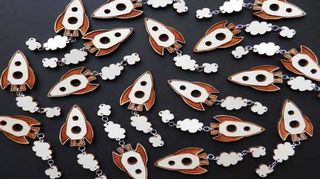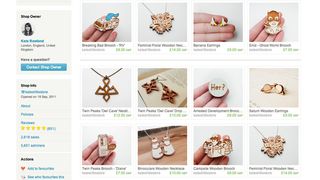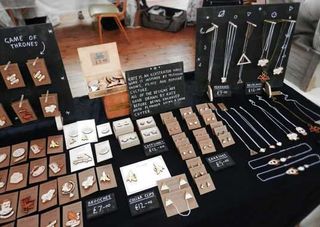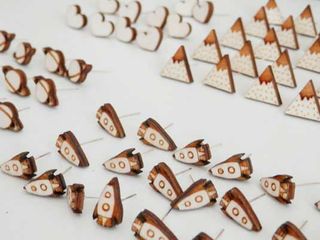Find a niche market for your designs: 6 pro tips
Catering to the mass market isn't the only way to make money from design. You just have to find the right niche, as illustrator Kate Rowlands reveals.
As creatives, we all want to produce work that's unique and worthwhile, but this often seems at odds with the commercial pressure to cater to the lowest common denominator. Yet the mass market isn't the only market with money. Find the right niche market and you could be in business, producing work you love in a way that'll keep you going right up to retirement.
Illustrator and jewellery designer Kate Rowland, from Bedford, UK, is a case in point. Not satisfied with just seeing her illustrations on paper, she moved into laser cutting.
Inspired by movies and television programmes like Breaking Bad, Game of Thrones and Twin Peaks, she began to recreate cult characters such as Walter White (above) in the form of brooches, necklaces and earrings, as well as other niche designs such as rockets. In little over a year, she's built up an impressive following and is selling in stores across the world.
From in-joke to must-have
"It started when my friend and I were watching Twin Peaks," recalls Rowlands. After deciding - as an in-joke - to make a piece of jewellery for her friend and sharing it on her website, her quirky design began to attract a lot of interest. So she began to make things inspired by other TV shows as well.

Now selling in 16 stores (including one in the USA, two in Europe and 13 in the UK), Notonthehighstreet.com and numerous markets, Rowland has a very shiny five star rating on Etsy, 5,216 admirers and a healthy level of sales.
In short, this 24-year-old graduate has done rather well in such a short space of time. So what are her top tips for breaking into a niche market and following in her footsteps?
01. Stick to what you know

The most important thing, says Rowland, is that you don't try to be something, or someone, you're not.
Get the Creative Bloq Newsletter
Daily design news, reviews, how-tos and more, as picked by the editors.
"A lot of people make things because they think they'll sell, rather than making something they like themselves," she points out. "Or they see a trend and they think - 'Oh I'll make something like that'. But that's a bad idea, because then you get a lot of similar stuff.
"If you want something completely different, you've got to start looking from a completely different perspective. Make something that you enjoy doing and don't worry too much about what other people think at first. That's what I've done."
02. Find an online platform

You'd be a fool not to take advantage of existing platforms on the web to market your products worldwide. Etsy has proved one of Rowland's most effective outlets, generating thousands of sales, as well as giving her a global platform, allowing collaborators to find her.
"It's really cheap, even if you're just selling a few things," she enthuses. "You don't have to pay anything to sell initially, you just pay a fee when you sell something." Of course, Etsy's just one site you can try - here are 14 more to check out.
03. Find a physical outlet

You can't beat the quality of face-to-face feedback, and so it's important to get out there and start selling in person. Rowland raves about the power of local craft fairs. "Even if it's a small local craft fair, just give it a go and see what people say," she enthuses. "At least you'll get a reaction to your work and then you can gauge whether it's a good idea or not.
Do some legwork too. Get out there and find some independent shops and ask if they'd like to sell your work. "Just try and get as much feedback from as many people as you can," Rowland stresses.
04. Seek out new audiences and outlets

Once you have your product, think carefully about where you can get the best sales. Finding stores online can be hard, because there are so many, so think about countries, industries, types of outlets, online or offline, supermarket or boutique shop. That should help you hone in on the outlets that will be most beneficial to you and your product.
Although she's a Brit, much of Rowland's jewellery has been inspired by American shows and movies, so it makes sense that her products are doing really well Stateside. Made, the indie emporium in Oklahoma, contacted her through Etsy and asked if she'd like to sell her items through them. Besides Etsy and Notonthehighstreet.com, it's now her best-selling channel.
05. Tell people about your product

With niche products more than any other, you need to think about your audience and what social media channels they would use.
Rowland loves Tumblr and Instagram for their visual appeal. Although also very visual, it can be harder to create a following on Facebook. Twitter, though, is great for promoting your work, interacting and networking with fans and potential collaborators. "Twitter allows you to speak to other people who are doing the same sort of thing as you and there's quite a good support network," she says.
Rowland makes good use of #handmadehour on a Wednesday evening between 7.30 and 9.30. With almost 8,000 followers @HandmadeHour is a great place to network and showcase your talent. For more tips, read our article How designers can make the most of social media.
06. Grow slowly but surely
A lot of people have a brilliant idea and then rush into it without giving proper thought to the product, how best to interact with their market and ultimately drum up sales. These are the ones who find it's all too much to handle and there's nothing worse than a broken dream.
It's normally better to test the waters first and not take on too much. "Start out really small and see if it works, then slowly build things up, based on what works and what doesn't," Rowland advises. Once you discover what works and what doesn't, you'll be able to better focus your efforts - and then the sky's the limit!
Kate Rowland is running a two-session jewellery workshop on 13 and 20 March from 7.30-9.30pm at Creative Biscuit Ceramics Café in South Woodford. The class costs £30 and includes all materials.
Words: Margaux Doey
Margaux Doey is a freelance journalist and winner of the PPA Magazine Academy's New Digital Product Concept 2013. Follow her on Twitter.
Liked this? Read these!
- The art of licensing: how to sell your designs to market
- Create a perfect mood board with these pro tips and tools
- The ultimate guide to logo design

Thank you for reading 5 articles this month* Join now for unlimited access
Enjoy your first month for just £1 / $1 / €1
*Read 5 free articles per month without a subscription

Join now for unlimited access
Try first month for just £1 / $1 / €1
The Creative Bloq team is made up of a group of design fans, and has changed and evolved since Creative Bloq began back in 2012. The current website team consists of eight full-time members of staff: Editor Georgia Coggan, Deputy Editor Rosie Hilder, Ecommerce Editor Beren Neale, Senior News Editor Daniel Piper, Editor, Digital Art and 3D Ian Dean, Tech Reviews Editor Erlingur Einarsson and Ecommerce Writer Beth Nicholls and Staff Writer Natalie Fear, as well as a roster of freelancers from around the world. The 3D World and ImagineFX magazine teams also pitch in, ensuring that content from 3D World and ImagineFX is represented on Creative Bloq.
